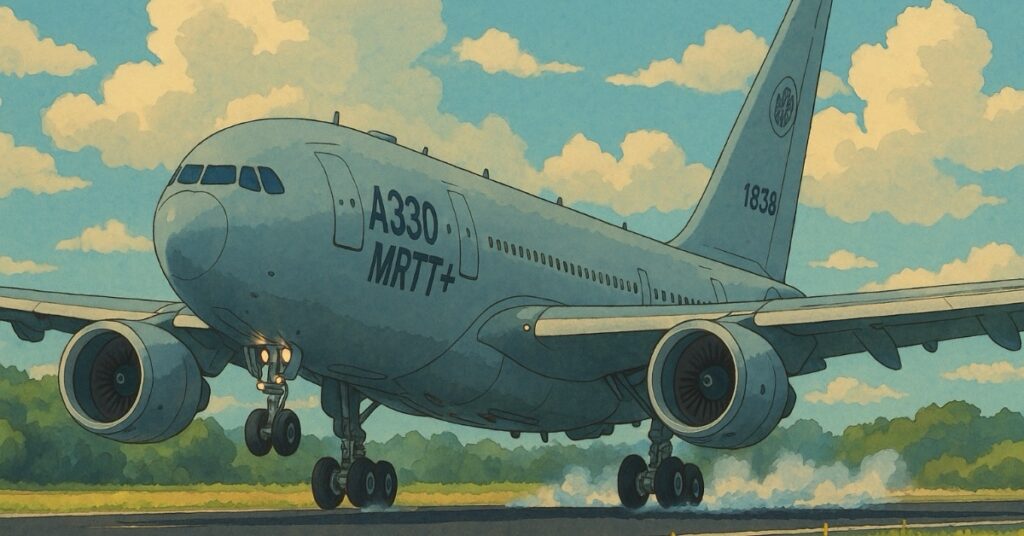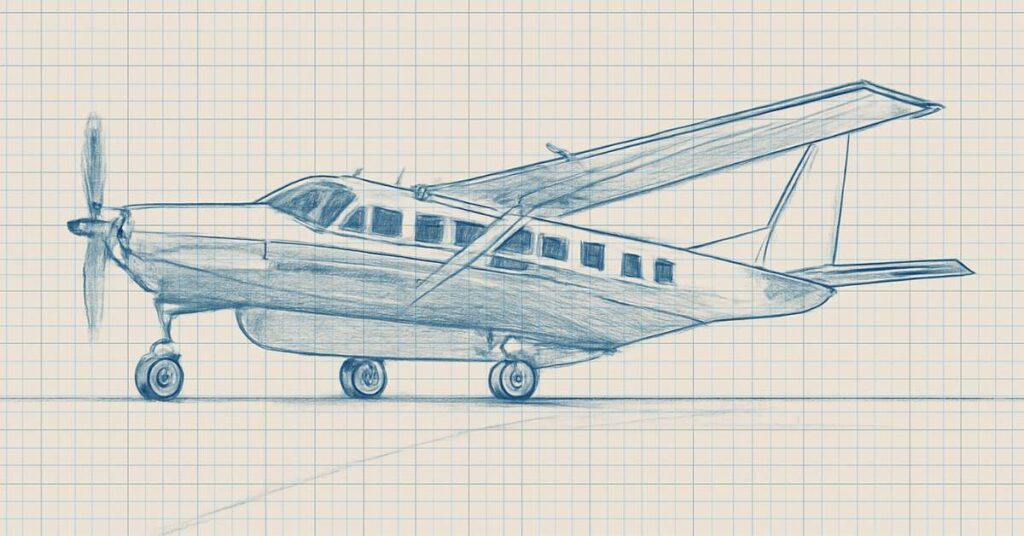It started with a farmer, a dream, and a dare to defy gravity. What followed was more than a company—it was the rise of one of the most iconic names in aviation history. Cessna Aircraft Company, born from Clyde Cessna’s relentless ambition in the Kansas heartland, went on to build planes that not only took off—but transformed how the world flies.
From the graceful monoplanes of the 1920s to the legendary Cessna 172 Skyhawk—the most produced aircraft in history—to the world-class Citation business jets, Cessna became the backbone of general aviation. Whether you’re a student pilot logging your first hour, a bush flyer skimming over Alaskan tundra, or a CEO crossing continents in a Citation Longitude, odds are you’re flying something with the Cessna name.
This is the definitive journey through Cessna’s aircraft legacy—from humble prop planes to high-altitude executive jets. Along the way, you’ll discover how this American company didn’t just build airplanes—it made aviation accessible, dependable, and aspirational for pilots around the globe.
📌 Related Read: Curious about how many Cessna aircraft have been built over the decades? Don’t miss our in-depth breakdown here: How Many Cessna Aircraft Have Been Built? A Complete Historical Production Overview
Chapter 1: The Farmer Who Refused to Crash (1911–1930s)
Before Boeing had its skyscrapers and before Lear had jets, Clyde Cessna stood in a Kansas cornfield with a handmade monoplane and a wild look in his eyes. It was 1911. He had no aviation degree—just stubbornness and a vision. He crashed the first dozen times he tried to fly. But on the 13th try, Clyde lifted off—and never came down again, at least in spirit.
By the late 1920s, Clyde had founded the Cessna Aircraft Company, built around his radical idea: monoplanes. At a time when biplanes ruled the skies, the Cessna AW, CW-6, and DC-6 glided overhead with a quiet elegance.
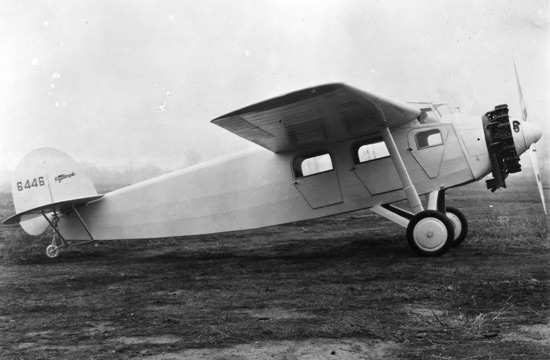
They were sleek, single-winged machines, with enclosed cockpits and the efficiency to outrun the old designs. It was like trading a horse cart for a sports car. But it was the C-34 Airmaster in 1935 that truly made aviation historians take notice. It was beautiful: a streamlined wooden fuselage, curved belly, cantilever wings, and a Warner Super Scarab radial engine up front. It could cruise at 145 mph when others were barely making 100. The Airmaster was a glimpse of what personal aviation could be: elegant, powerful, modern.
Chapter 2: War Wings and the Postwar Boom (1940s–1950s)
World War II put civil aviation on pause—but not innovation. Cessna pivoted to become a wartime workhorse. It built over 5,000 twin-engine trainers like the AT-17 Bobcat, and even assembled the Waco CG-4A gliders—canvas-and-wood behemoths used in silent assaults across Europe.
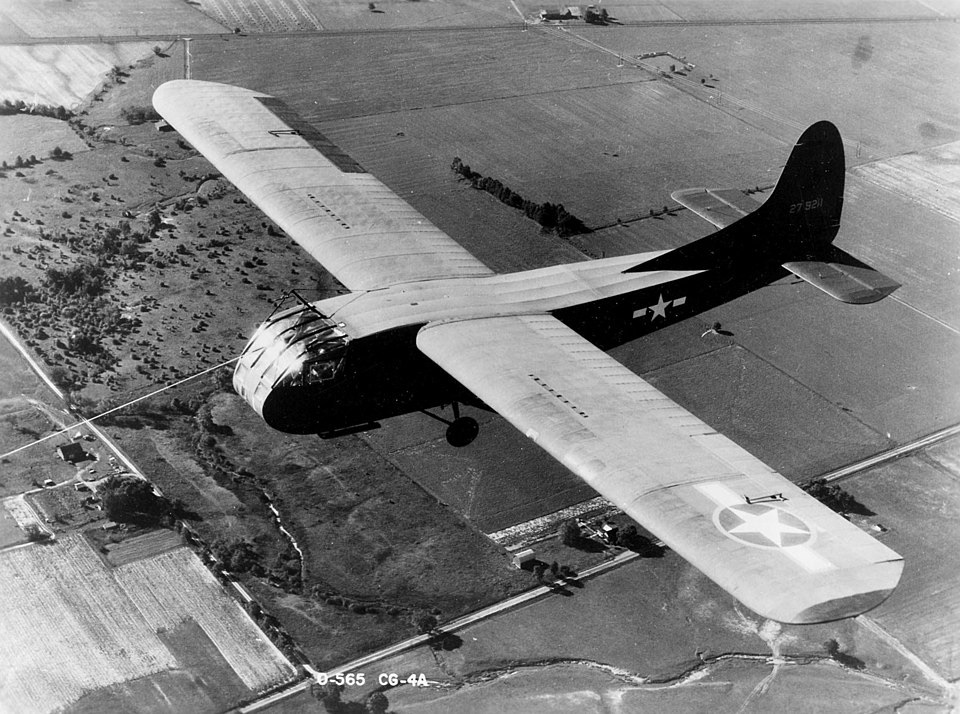
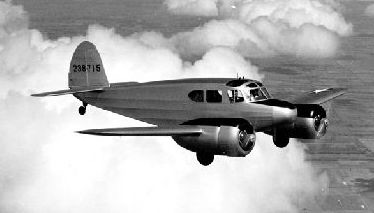
Then the war ended—and everyone wanted to fly. In 1946, Cessna returned with the Model 120 and 140: taildraggers with metal skins and stick-and-rudder charm. Suddenly, owning an airplane was within reach. You didn’t need to be rich—you just needed a passion for flight and a little savings.

Two years later came the Cessna 170—a four-seat evolution that combined utility and family travel. With a Continental engine and rugged tailwheel gear, it became beloved by bush pilots, flight schools, and families alike. But something bigger was coming…
Chapter 3: The Birth of the Skyhawk (1956–1960s)
1956: The Tricycle Gear Takes Off
In 1956, Cessna didn’t just tweak an airplane—it redefined an era. By taking the tailwheel Cessna 170, adding a nosewheel, and refining the aerodynamics and cockpit layout, they gave birth to the Cessna 172 Skyhawk—an aircraft so stable, forgiving, and intuitive that it would go on to become the most produced airplane in history. The Skyhawk had docile stall behavior, exceptional visibility, and just the right balance between control feedback and comfort. It wasn’t intimidating. It was inviting. With four seats, room for baggage, and 900 miles of range, it was the flying family car America didn’t know it needed. And pilots loved it. As the FAA certified it, instructors lined up to use it. Students fell in love with its predictability. Families bought them for weekend getaways. And over 44,000 Skyhawks have been built since—a record unmatched in the skies.
“The 172 was like a golden retriever with wings—loyal, dependable, and always ready to go.” – Aviation legend Barry Schiff
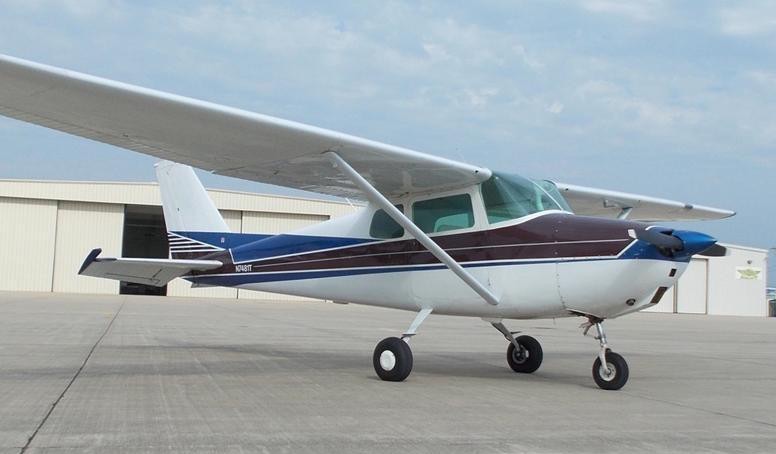
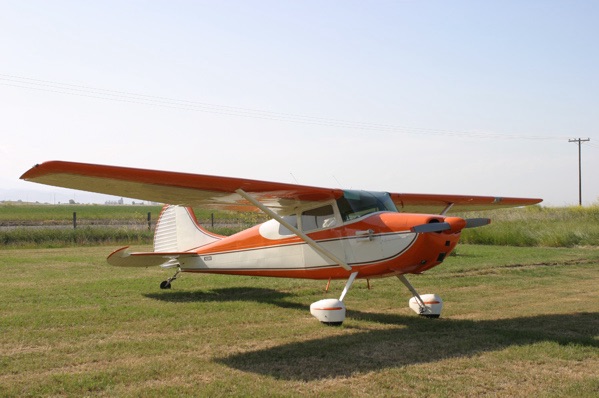
Cessna Doubles Down on Flight Training
Riding the Skyhawk’s success, Cessna introduced smaller, two-seat siblings: the Cessna 150 and 152. These were bulletproof trainers—metal birds that could take a hundred hard landings and come back asking for more. With responsive control surfaces, just enough engine power, and unmatched operating economics, they became the workhorses of flight schools across the world. For tens of thousands of pilots, the 150 or 152 was their first solo, their first cross-country, their first logbook entry.
Cessna 175 Skylark: Ambition on a Budget
In 1958, the Cessna 175 Skylark aimed to bridge the gap between the 172 and the more powerful 182. It featured a geared Continental GO-300 engine that delivered better climb performance and higher cruising speeds—on paper. But in practice, the geared engine was temperamental and didn’t win universal love. Still, for those who flew a well-maintained Skylark, it offered smooth performance, refined trim, and a unique place in the Cessna story.
Today, it’s a cult favorite—a hidden gem for those who know how to treat it right.
Cessna 177 Cardinal: Beauty and Innovation in One
Then came 1968—and the Cessna 177 Cardinal. With its sleek, strutless cantilever wing, wide doors, and all-moving stabilator, it was designed as a modern replacement for the 172. Visually stunning and aerodynamically advanced, it looked fast just sitting on the ramp.
But early models were underpowered, with only 150 hp. The 177B, introduced in 1970 with a 180-hp Lycoming, solved that. It gave the Cardinal the muscle it needed to match its looks. With its spacious cabin, excellent forward visibility, and elegant lines, the Cardinal attracted pilots who valued form and function equally.
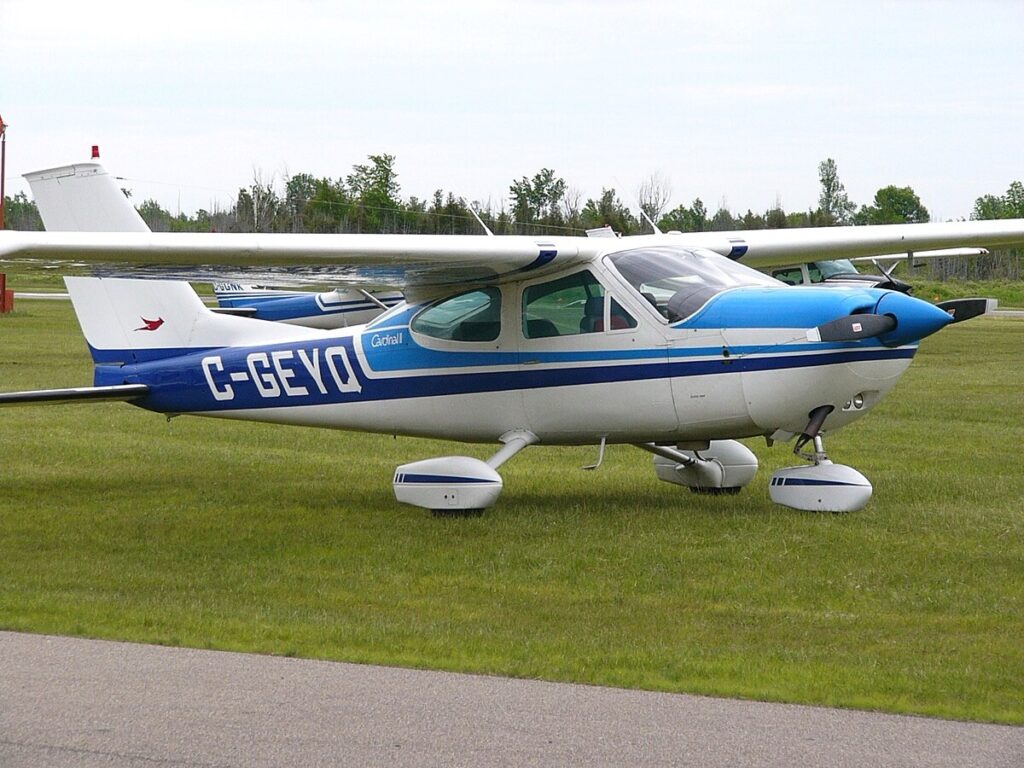
Chapter 4: The Sky Gets Bigger — Power, Payload, and Purpose (1960s–1980s)
As general aviation matured in the 1960s and ’70s, flying was no longer just about learning the ropes or weekend getaways. Pilots and operators needed aircraft that could go farther, carry more, and handle real-world demands. Cessna rose to the challenge, building a fleet that combined utility, performance, and reliability like never before.
Cessna 180 & 185 Skywagon: Bush Legends
The Cessna 180, introduced in 1953, and its more muscular sibling, the Cessna 185 Skywagon, became icons of backcountry aviation. With their rugged tailwheel configurations, oversized tires, and high-lift wings, these aircraft didn’t just land on runways—they landed on gravel bars, tundra, snow, ice, and even glaciers.
In Alaska, Canada, and the bush territories of Australia, they became lifelines—hauling supplies, mail, and people to places roads could never reach. The 185’s 300-horsepower Continental engine gave it muscle to climb over mountains and lift heavy loads, even from short, unimproved strips. Today, it’s still a holy grail for bush pilots, prized for its brute strength, STOL capability, and no-nonsense design.
As famed Alaskan pilot Don Sheldon once put it:
“There’s no such thing as bad weather—only the wrong aircraft.”
And more often than not, the right aircraft in the wild was a Cessna.
Cessna 182 Skylane: The Skywagon Refined
For pilots wanting the muscle of a 180 but the manners of a 172, Cessna introduced the 182 Skylane. It swapped the taildragger stance for tricycle gear, added interior refinements, and kept the performance strong. It could cruise near 145 knots, climb aggressively even at altitude, and carry four adults, full fuel, and luggage—making it one of the most popular step-up aircraft of all time. Whether it was used for cross-country travel, backcountry camping, or serious IFR training, the Skylane earned its place as the backbone of general aviation.
Cessna 206, 207, and 210: Load Haulers and Speed Demons
When more seats and more payload were needed, Cessna delivered.
- The Cessna 206 Stationair became the go-to aircraft for air taxis, bush operators, and skydiving schools. Its wide double doors in the rear made cargo loading a breeze—whether that was drums of fuel, construction gear, or jumpers in flight suits.
- The Cessna 207, a stretched version, added another seat row and extra room—ideal for rugged charter work in Alaska and beyond.
- Then came the Cessna 210 Centurion, a retractable-gear powerhouse that took the proven 6-seat layout and gave it speed and sleekness. With cruise speeds approaching 170–180 knots, it blurred the line between high-performance piston and entry-level twin. The 210 was fast, efficient, and surprisingly capable in high-density altitudes—making it a cross-country king.
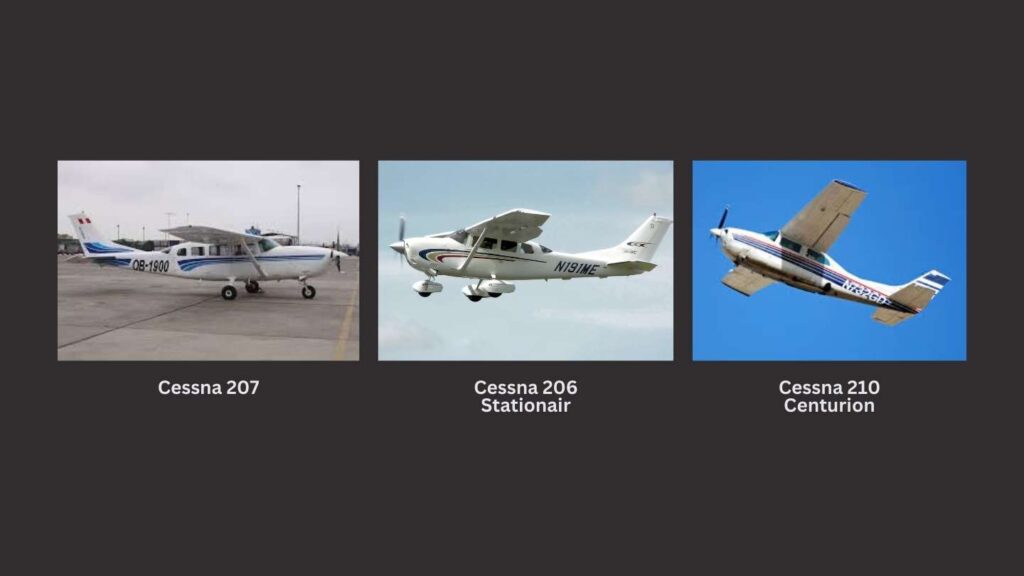
Cessna Dominates Twin-Engine Territory
As pilots moved up from singles, Cessna offered a dizzying range of twins, each filling a niche with precision.
- The Cessna 310, introduced in the 1950s but reaching its stride in the ’60s, oozed mid-century cool. With sleek lines, tip tanks, and 280-hp engines, it flew as sharp as it looked. Seen in films and TV shows, it was a Hollywood icon that actually delivered real-world performance.
- The Cessna 337 Skymaster was pure aviation creativity: a centerline thrust twin with engines in front and back—no asymmetric thrust, no yaw drama. It sounded like a sci-fi spaceship and flew like a trainer. The military O-2 variant saw action in Vietnam and elsewhere as a forward air control platform.
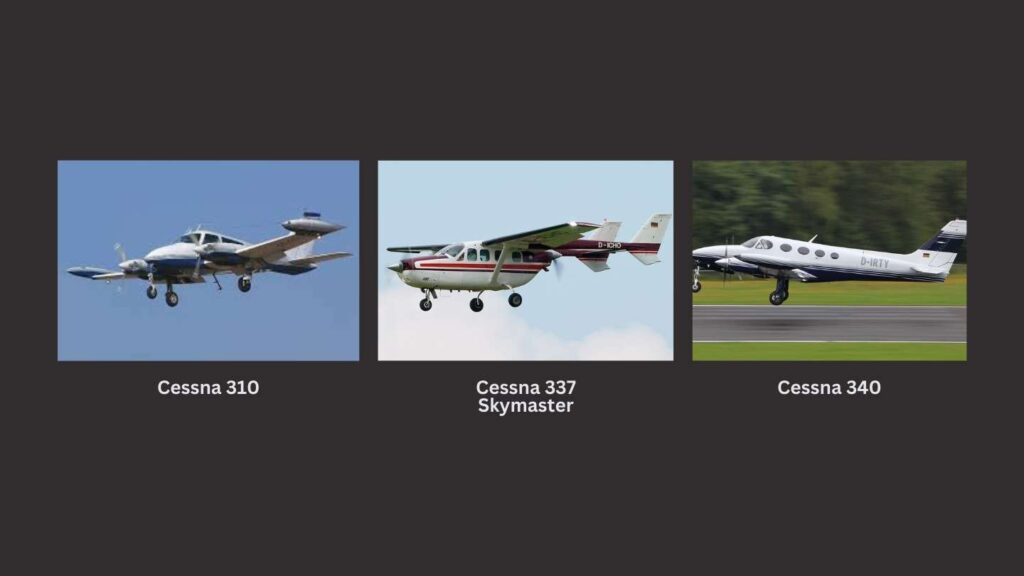
Then came the executive fleet:
- Cessna 340 – pressurized and comfortable, perfect for business travel.
- Cessna 401 & 402 – utility twins ideal for cargo and commuter flights.
- Cessna 411 & 414 Chancellor – larger cabins and long legs for serious business use.
- Cessna 421 Golden Eagle – the flagship piston twin: pressurized, luxurious, with twin 375-hp Continental GTSIO-520s and a ride smooth enough to rival turboprops.
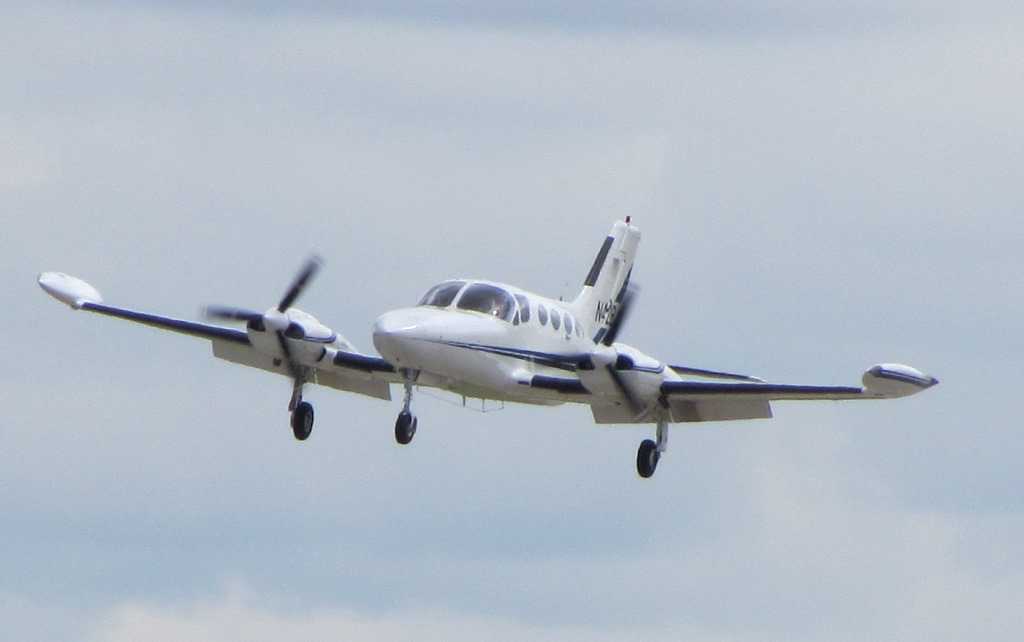
For many, the 421 represented the peak of the piston-powered executive aircraft era. It was quiet, spacious, and refined—flying above the weather and expectations.
Chapter 5: Turboprop Thunder and Sky Utility (1980s–Today)
By the 1980s, the golden era of piston-powered general aviation was giving way to a new force: turbine propulsion. Faster, more reliable, and better suited for commercial and remote operations, turboprops were the future—and Cessna didn’t just adapt, it led the transformation.
The revolution began with the Cessna 208 Caravan, introduced in 1984. This rugged, high-wing, single-engine turboprop was designed to go where few others could. Built to haul both people and cargo into unforgiving environments, the Caravan combined STOL (short takeoff and landing) performance with turbine reliability.
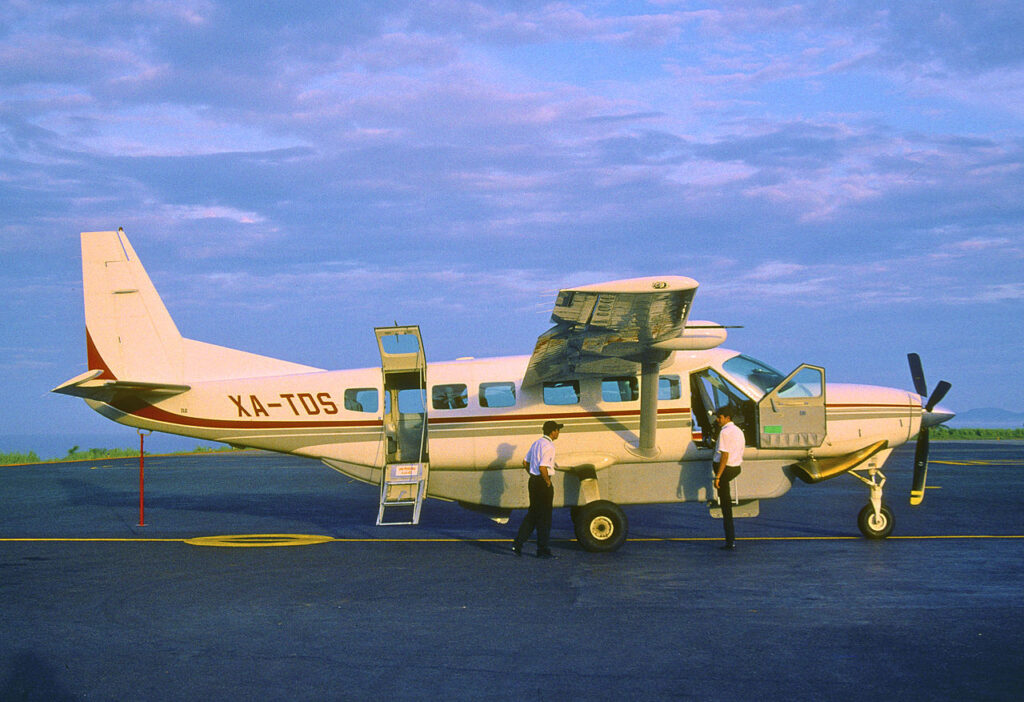
It became an instant global workhorse. In the Australian Outback, it carried mail and medicine. In Papua New Guinea, it served missionary routes through jungle valleys. In Africa, it delivered aid to dirt-strip airstrips where jetliners dared not land. It took tourists across the Maldives, shuttled scientists to remote research stations, and served in dozens of militaries as a surveillance platform, trainer, and transport.
The Caravan evolved quickly:
- The Grand Caravan EX added more power, payload, and passenger capacity.
- Amphibious versions took to the seas with Wipaire floats.
- The Cessna AC-208 Combat Caravan, equipped with ISR gear and even weapons, provided an affordable tactical aircraft solution for nations needing low-cost airpower.
By the 2000s, the Caravan had become the gold standard in utility aviation, with over 3,000 aircraft delivered and operations in more than 100 countries. Its versatility, rugged airframe, and minimal maintenance needs made it irreplaceable for operators from humanitarian aid groups to regional air carriers.
But Cessna didn’t stop there. For operators needing more speed and cabin pressurization, Cessna introduced the Model 425 Corsair and the 441 Conquest II. Both were twin-engine turboprops that combined the best of piston economics with jet-like performance.
- The Cessna 425 Corsair, later known as the Conquest I, offered a pressurized cabin, twin Pratt & Whitney engines, and cruise speeds approaching 300 knots. It was a favorite among business flyers looking for reliability without the cost of a jet.
- The 441 Conquest II took things further. Capable of 30,000-foot cruise altitudes, 330-knot speeds, and transcontinental range, it delivered business jet performance for a turboprop price. With trailing-link landing gear, a sleek profile, and powerful Garrett TPE331 engines, it became a cult favorite among seasoned pilots. It was fast, efficient, and remarkably smooth in rough weather.
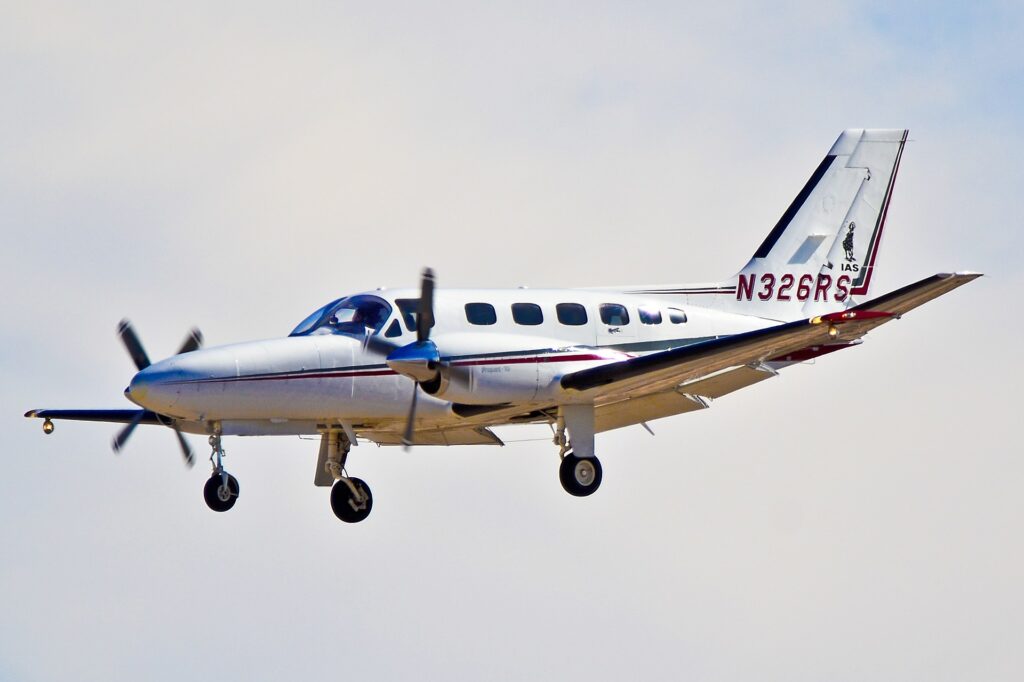
Together, the Caravan, Corsair, and Conquest represented Cessna’s shift from traditional general aviation to true aerial utility and business-class transport. These aircraft weren’t just for recreation or training—they were tools, used by companies, governments, NGOs, and military forces across the globe.
By the late 20th century, Cessna was no longer just making planes. It was building aerial infrastructure: connecting supply chains, delivering critical services, and opening parts of the world that had once been unreachable by air.
In the turboprop era, Cessna didn’t just keep flying. It expanded the map.
Chapter 6: Citation Series — The Jet Set’s Workhorse
Cessna’s most surprising and perhaps most transformative achievement didn’t come from its legendary piston-engine trainers or rugged bush planes. It came from jets.
When Cessna introduced the Citation I in 1972, the business aviation world barely blinked. The aircraft was slower than its sleek competitors like the Learjet 24, and its straight wing design limited top-end speed in favor of safer handling. Critics dismissed it, derisively calling it the “Slowtation.” But what they overlooked was exactly what pilots valued: simplicity, economy, and usability.
The Citation I could be flown by a single pilot, maintained affordably, and operated from shorter runways than most jets—opening up thousands of smaller airports for business travel. You didn’t need a professional flight department or a massive corporate budget to own and fly one. And that was revolutionary. The Citation I wasn’t built to impress—it was built to work. And in the world of aviation, reliability often wins the race.
That race soon turned into a dynasty. Cessna responded to early feedback with a steady evolution. The Citation II, launched in 1977, increased seating capacity, range, and speed, quickly becoming one of the best-selling business jets of its time. The Citation V, Ultra, and Encore followed—each one more capable, refined, and efficient. These aircraft brought true coast-to-coast capability, comfortable six- to eight-seat cabins, and performance that met the growing demands of corporate operators, air charter services, and owner-pilots alike.
Then came the CitationJet (CJ) series—and the game changed again.
Starting with the CJ (Model 525) in 1993 and progressing through the CJ1, CJ2, CJ3, and CJ4, this family of jets became the backbone of the light jet market. All were certified for single-pilot operation, making them a favorite for entrepreneurs and owner-operators. These aircraft offered a winning combination of high-speed cruise, low operating costs, excellent short-field performance, and glass cockpits. The CJ4, introduced in 2010, could fly over 2,100 nautical miles at 451 knots—blurring the line between light and midsize jets.
In 2006, Cessna introduced the Citation Mustang, a bold entry into the emerging Very Light Jet (VLJ) category. It was the first fully certified VLJ in the world, offering turbine reliability and a pressurized cabin for the price of a high-end turboprop. With seating for four passengers, a range of 1,200 nautical miles, and cruise speeds of 340 knots, the Mustang became an instant favorite among flight schools, air taxi operators, and owner-pilots looking to break into the world of jets.
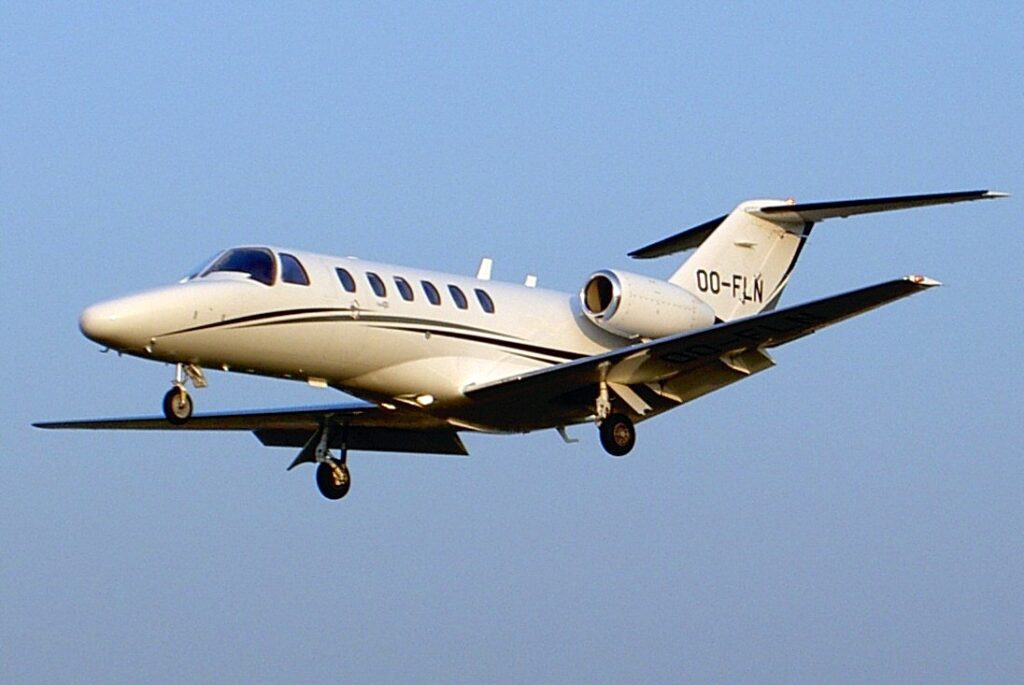
The Citation M2, launched in 2013 as the Mustang’s spiritual successor, added more power, Garmin G3000 avionics, and modern styling. It provided a “jet upgrade path” for piston pilots with its sporty handling, refined cabin, and entry-level jet affordability. In the midsize market, Cessna expanded with the Citation Excel, followed by the XLS and XLS+. These jets struck the perfect balance: eight to ten seats, coast-to-coast range, excellent climb rates, and the ability to operate from shorter runways than most of their class. They were fast, reliable, and ideal for both charter and corporate use, quickly becoming some of the most flown business jets in the world.
Then came the long legs. The Citation Sovereign brought transcontinental range, a 9-passenger cabin, and high-speed cruise near 460 knots. Its high-wing loading gave it a famously smooth ride in turbulence, while updated avionics and elegant interiors kept passengers and pilots equally happy.
By 2015, Cessna raised the bar again with the Citation Latitude, a revolutionary aircraft in the midsize jet market. With its flat-floor cabin, 6 feet of standing height, and spacious, wide fuselage, it felt like a super-midsize jet at a midsize price. It also featured the most pilot-friendly cockpit Cessna had ever built, powered by Garmin G5000 avionics and highly automated systems.
And at the pinnacle? The Citation Longitude. Unveiled as Cessna’s flagship in the super-midsize jet category, the Longitude delivered 3,500+ nautical miles of range, cruise speeds over 480 knots, and a whisper-quiet, exquisitely appointed cabin. It featured touchscreen avionics, high-efficiency engines, advanced diagnostics, and luxury finishes more commonly found in heavy jets. With the Longitude, Cessna wasn’t just keeping up—it was leading.
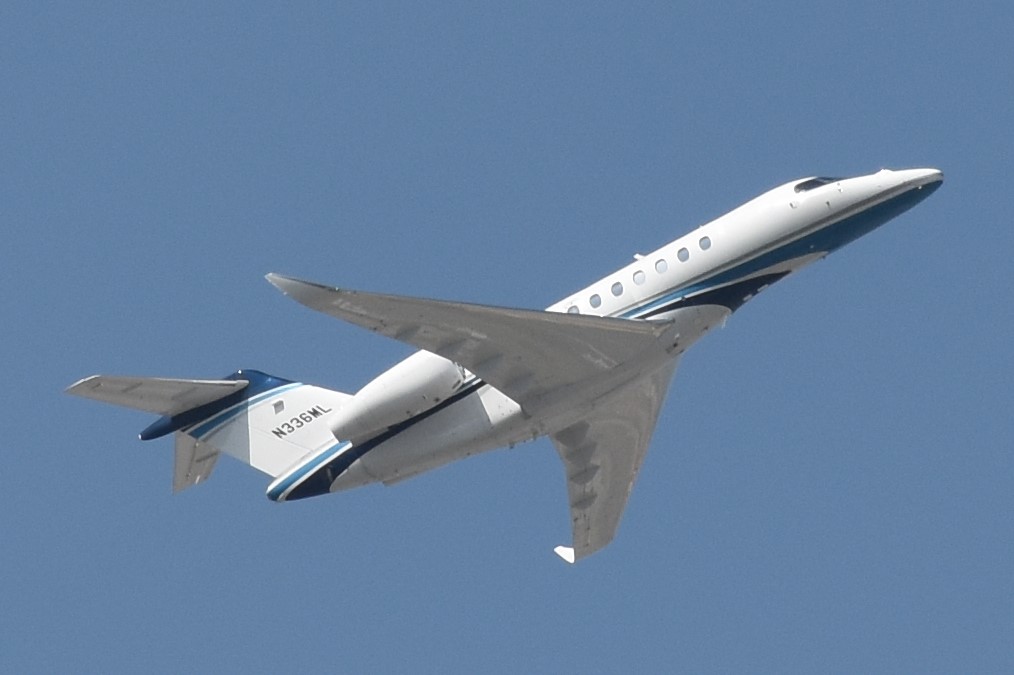
Across the Citation series—spanning more than 25 models and over 8,000 deliveries—Cessna achieved something few manufacturers ever do: it created a brand within a brand. Citation jets became synonymous with practical luxury, operational efficiency, and pilot-first engineering. Cessna didn’t just build a jet for the elite. It built jets that anyone with vision, grit, and a reason to fly could access. And that made all the difference.
Epilogue: The Legacy That Keeps Flying
Cessna has built over 200,000 aircraft, flown in every country, on every continent—including Antarctica. It’s trained the world’s pilots, delivered aid across jungles, carried tycoons, and lifted hearts. But it all started with one man in a Kansas barn. He built a monoplane with his hands. He crashed. Then he tried again. And again. And on the 13th try, he flew.
Today, every Skyhawk, every Caravan, every Citation—whispers that same truth: “You can fly, too.”
